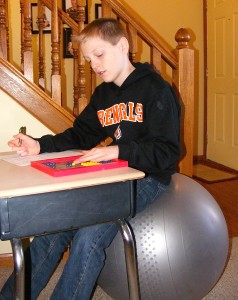Help! I just found out that my child has been diagnosed with…. Will RightStart Math help?
We receive requests at conventions and numerous emails for help for the ‘Struggling Learner’. I, too, have been in that position – actually twice now. I have four children, two of which are struggling learners – one significantly so. Fortunately, I discovered RightStart Math early and have used it and am currently using it for all of my children. Over the years, 11 years to be exact, I have found things that work. Things that don’t work. And various ‘tips’ that I have used as I teach my kids. So, here is my blog of helpful ideas that might be helpful to you, even if you don’t have a child with ‘special needs’ or ‘differently abled’ or whatever the terminology of the day is!
The ‘Antsy’ Child
Do you have a child who just simply can’t sit still? Perhaps he has officially been diagnosed with ADHD or maybe she just had too much sugar for breakfast. Either way, how can you work with a child who simply can’t sit still? Here is an idea you may want to try. And there will be plenty more to follow!
Use an exercise ball instead of a chair. WHAT?! That’s what I said. Many kids who cannot sit still actually NEED movement to help them learn. If the ‘antsy child’ is expected to sit still in a chair, I guarantee they are thinking, “Sit still. Sit still. Sit still. I wanna move but I need to sit still.” They are not paying attention to anything you are saying. They are completely focused on sitting still. So, let them move. You can keep their movement contained at their desk by using a large exercise ball for them to sit on.
The ball will help them wiggle and move – but still provide an environment appropriate for the classroom. A recent study was done at the University of Central Florida on ADHD and enhancing learning. They report: “What we’ve found is that when they’re moving the most, the majority of them perform better. They have to move to maintain alertness.”
Card Game Antics
Playing lots of math card games is an excellent way to help the child move and practice their math facts at the same time! Why not have your child sit on the floor, not at the desk, while playing the games? That way she can wiggle on the floor as much as she wants.
How about turning the math card game into a relay race? For example, when playing Find The Tens Memory game, have your child flip over two cards to see if he can find a match. If a match is found, run to the other side of the room and back. If a match is not found, run twice! It is great fun and creates lots of giggles!
Since many of us have made New Year’s resolutions for improving health and fitness, why not try these ideas and you do them alongside your child? A little bit of running in the room is good cardiovascular exercise and the exercise ball is excellent for the abs!
If you have a special learner in your family and have questions or your own tips, please feel free to email RightStart Math at [email protected]. Perhaps it will show up on a future blog post!


Thanks for the tips, Rachel! I have been thinking about trying the exercise ball with my son. i need to get it out of the basement and give it a try. I am looking forward to future blog posts in this series.
How big is the ball
This is a general exercise ball. I inflated it to fit the size of the student.
Any tips for children with dyscalculia? My daughter has had a horrible time learning to count. I started Rightstart A when she was 5. She is now 7 and still has a very hard time recognizing the numbers on the abacus and counting without me. She has made some progress, but she still struggles and gets extremely frustrated when it is time for math.
Sharon – I am getting ready to post a blog on this exact topic!!
My daughter loves the games but I had not thought about having a relay! I bet we could really think outside the box and come up with a ton of ideas to get some energy out. Hmmm…I’ll be dreaming about these ideas tonight. ha!